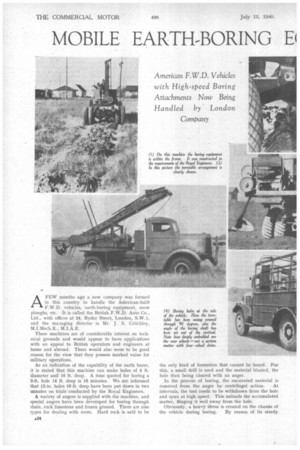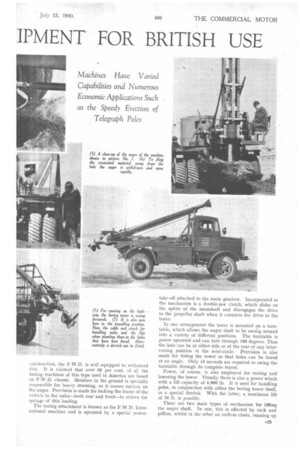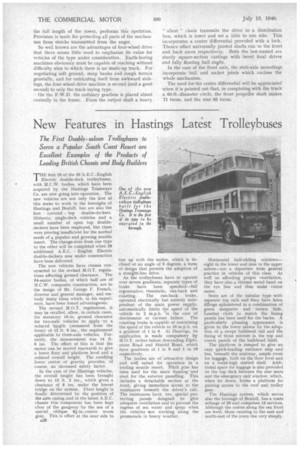MOBILE EARTH-BORING El IPMENT FOR BRITISH USE
Page 26

Page 27

Page 28

If you've noticed an error in this article please click here to report it so we can fix it.
AFEW months ago a new company was formed in this country to handle the American-built F.W.D. vehicles, earth-boring equipment, snow ploughs, etc. It is called the British F.W.D. Auto Co., Ltd., with offices at 24, Ryder Street, London, S.W.1, and the managing director is Mr. J. S. Critchley, M. I .Mech.E. , M.I .A.E.
These machines are of considerable interest on technical grounds and would appear to have applications with an appeal to British operators and engineers at home and abroad. There would also seem to be good reason for the view that they possess marked value for military operations.
As an indication of the capability of the earth borer, it is stated that this machine can make holes of 4 ft. diameter and 16 ft. deep. A time quoted for boring a 3-ft. hole 14 ft. deep is 10 minutes. We are informed that 12-in. holes 10 ft. deep have been put down in two minutes on trials conducted by the Royal Engineers.
A variety of augers is supplied with the machine, and special augers have been developed for boring through shale, rock limestone and frozen ground. There are also types for dealing with roots. Hard rock is said to be the only kind of formation that cannot be bored. For this, a small drill is used and the material blasted, the hole then being cleared with an auger.
In the process of boring, the excavated material is removed from the auger by centrifugal action. At intervals, the tool needs to be withdrawn from the hole and spun at high speed. This unloads the accumulated matter, flinging it well away from the hole.
Obviously, a heavy stress is created on the chassis of the vehicle during boring. By reason of its sturdy koti.,,tritction, the F.W.D. is well equipped to withstand this. It is claimed that over 95 per cent. of all the boring machines of this type used in America are based on F.W.D. chassis. Moisture in the ground is specially responsible for heavy stressing, as it causes suction on the auger. Provision is made for locking the frame of the vehicle to the axles—both rear and front—to relieve the springs of this loading.
The boring attachment is known as the F.W.D. International machine and is operated by a special power
take-off attached to the main gearbox. Incorporated in the mechanism is a double-jaw clutch, which slides on the spline of the mainshaft and disengages the drive to the propeller shaft when it connects the drive to the borer.
In one arrangement the borer is mounted on a turntable, which allows the auger shaft to be swung around into a variety of different positions. The turntable is power operated and can turn through 180 degrees. Thus the hole can be at either side or at the rear or any intervening position in the semi-circle. Provision is also made for tiiting the tower so that holes can be bored at an angle. Only 15 seconds are required to swing the turntable through its complete travel.
Power, of course. is also employed for raising and lowering the tower. Usually there is also a power winch with a lift capacity of 4,000 lb. It is used for handling poles, in conjunction with either the boring tower itself, or a special derrick. With the latter, a maximum lift of 70 ft. is possible.
There are two main types of mechanism for lifting the auger shaft. In one, this is effected by rack and piition, whilst in the other an endless chain, running up the full length of the tower, performs this operation. Provision is made for protecting all parts of the mechanism from shocks transmitted from the auger.
So well known are the advantages of four-wheel drive that there seems little need to emphasize its valuefor vehicles of the type under consideration. Earth-boring machines obviously must be capable of reaching without difficulty sites to which there is no made-up track. For negotiating soft ground, steep banks and rough terrain generally, and for extricating itself from awkward sinkings, the four-wheel-drive machine is second (and a good second) to only the track-laying type.
• On the F.W.D. the ordinary gearbox is placed about centrally in the frame. From the output shaft a heavy " silent " chain transmits the drive to a distribution box, which is lower and set a little to one side. This incorporates a centre differential provided with a lock. Thence offset universally jointed shafts run to the front and back axles respectively. Both the last-named are sturdy square-section castings with bevel final drives and fully floating half shifts.
In the case of the front axle, the stub-axle mountings incorporate ball and socket joints which enclose the whole mechanism.
The need for the centre differential will be appreciated when it is pointed out that, in completing with the truck a 60-ft.-diameter circle, the front propeller shaft makes 71 turns, and the rear 63 turns.




















































